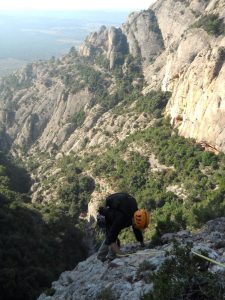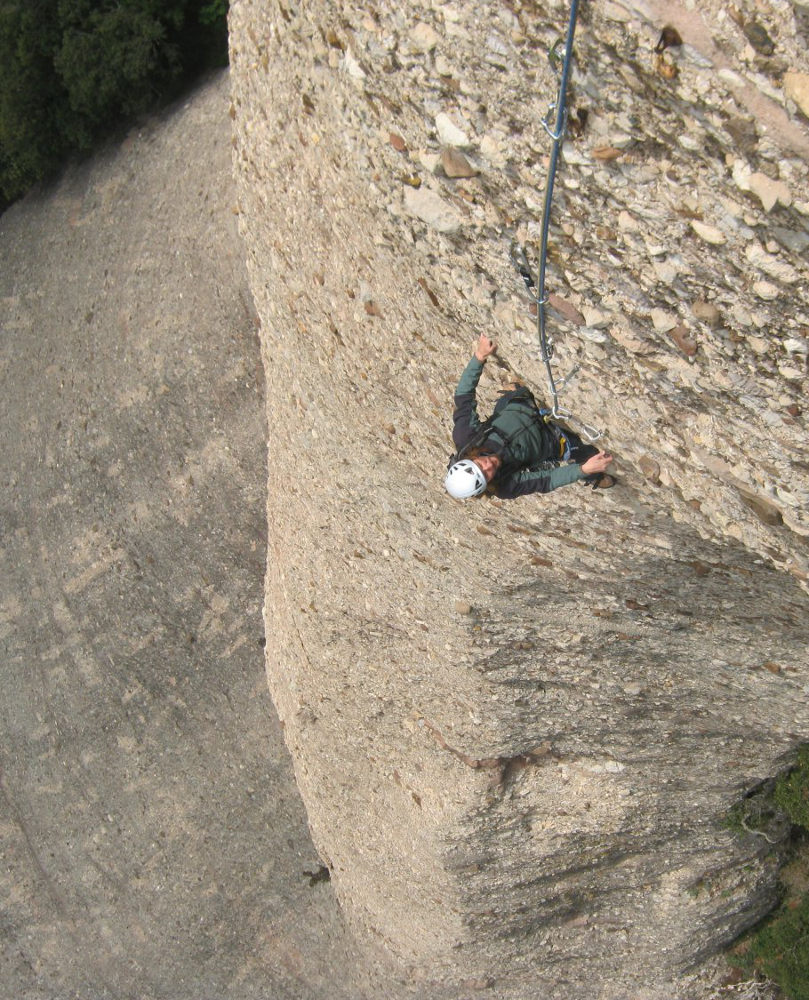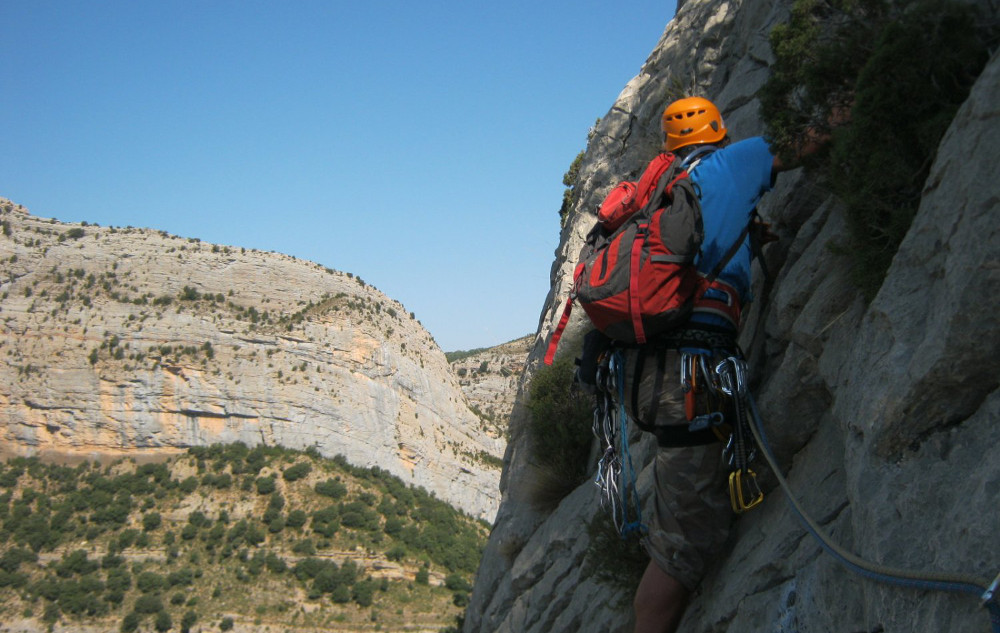TOPO
Esparraguera a la Roca Gris, Montserrat, Spain
This Saturday, we discovered a new climbing area, ideal for winter because of its southern exposure: the Roca Gris above Vinya Nova, overlooking the torrent del Pont. The Esparraguera route up the south ridge of this large rock is accessible and aerial, offering a wide-open panorama over the southern plain of Montserrat. With the exception of a V+ slab, the level remains reasonable in a V that is well sustained in places, and otherwise IV+. Note the quality of the rock, which is often quite crumbly, and especially the 5th pitch, which is very exposed and completely unequipped, requiring friends and/or belayers to protect the ascent. The route is still very enjoyable and well worth the detour.

arrivée au relais R3
Technical summary
Access to the place
Take the A2 from Barcelona towards Leida and exit at Bruc, junction 572. Pass through the residential area and take the track leading to the Vinya Nova restaurant. Park in the lower parking lot, where the cami del torrent del Pont starts, leading to the foot of the track.
Itinerary description
Hiking to the start 30'
Take the path heading due north. Once you've passed the restaurant fence, turn right and follow the bed of the torrent del Pont. Continue along the stone bed for a few hundred metres before turning right onto a path that winds upwards, with white markings. Higher up, you come to the foot of the Pollego de Vinya Nova, another great climbing area. Keep going. The path goes deeper, broadly following the course of the torrent above. The Roca Gris comes into view, clearly recognizable with its large southern ridge. We then cross a small canal (return path) and reach the foot of the Roca Gris. Leave the path and climb a few metres up the rock to reach a small holm oak at the base of the wall, the starting point for the first pitch.
Course
The route, opened in 1994, is south-facing and 6 pitches long (25m, 35m, 25m, 50m, 15m, 35m). Bring 12 quickdraws, belay and Sabine ropes, and a set of friends (L5). Maximum level V+.
L1 (25m, IV+)
Be careful, as the rock is crumbly. Climb carefully, watching where you put your hands and feet. To reach the first nail (which is a little high), you can use a sabine on the left. The rest of the climb is easy, as you thread your way along the most solid parts to reach the R1 belay on a slight flat. The pads are far away and require 2 lanyards to climb the belay.
L2 (35m, V)
Well-equipped pitch (new and old equipment). Start right into the fault and climb left onto the large plate. An almost vertical passage in a steady V then an easier finish with fewer belay points. We arrive at the top of a mini-needle and the comfortable R2 belay is on the other wall opposite.
L3 (25m, V+)
This is the most difficult part of the route. Climb up a few meters to find yourself at the foot of a vertical wall. 2 or 3 fairly thin V+ steps but good holds. Exit further up to the left, then cross the ridge again to reach the top of another mini-needle and find the R3 belay on the next wall, on the other side of a fault. The route gains height and the view widens.
L4 (50m, V)
The longest, very aerial and very pleasant. It starts directly with a large, almost vertical plate in a well-equipped, sustained V. The 2nd part is more inclined in IV+ with few nails. It ends in III to reach the R4 belay to the left of a tree and at the foot of the "head" of the Roca Gris, which rises above us.
L5 (15m, IV+)
This is a traverse to the entrance of the final dihedral. Descend to the right, pass over the branches of the tree and climb straight up to reach the only nail of the length, which is a bit high! You can rig a sabine just after it, or place a friend in the beautiful crack that helps you climb. We then have to traverse horizontally, unprotected, to the R5 belay on the right, under the "head" of the roca.
L6 (35m, IV+)
The most exposed pitch! Climb straight up the huge dihedral. Allow for 2 or 3 friends to be placed in the cracks if you want to protect the passage. Climb the slab on the right, as the left side (rock + crack) looks a bit flimsy... The exit is also very steep to reach the summit. After the final exit from the dihedral (phew!), you'll need to rig up a sabine and then climb the R6 belay in a tree.
Back
From the summit, climb the ridge for a hundred metres or so to find the R3 belay at the end of the Olmo-Urquiza route on the right (do not take the first belay on the right just after the summit). 3 abseils of a good 50 metres or so on the large slab which descends to the right and runs along a diagonal dihedral. At the bottom of the Olmo-Urquiza, descend the small canal that joins the approach path, which we retrace in the opposite direction to the parking lot.




























Leave a Reply